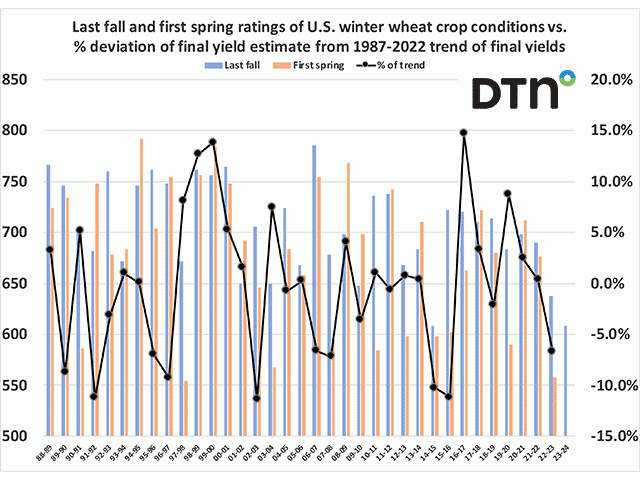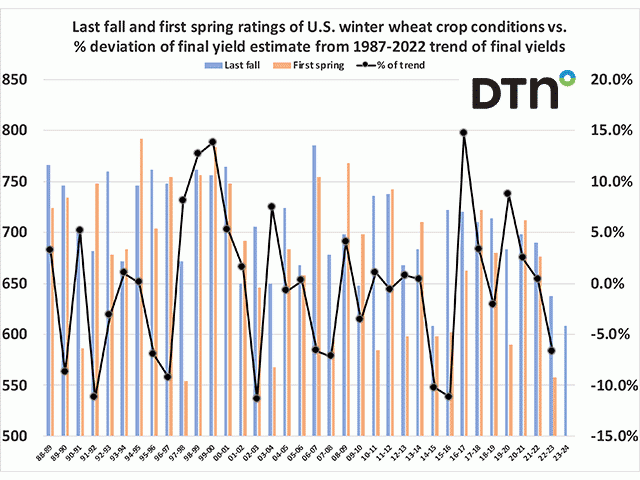Fundamentally Speaking
2023 US Winter Wheat Crop Heading Into Dormancy in Worst Shape Ever Based on USDA End-of-November Ratings
Wheat was the weakest member of the CME ag complex in November. But the reason supportive is a very troubled 2023 U.S. winter wheat crop. Though this week's USDA final winter wheat crop condition ratings of the fall pegged 34% of the crop as either good or excellent, which is up two percentage points from the previous week and 6% from the initial rating for the 2023 crop and higher than the trade guess of a 1% increase, it will still enter dormancy in about the worst shape ever for U.S. winter wheat.
A year ago when yields came in well-below trend with a very low harvested-to-planted ratio of 70%, the crop was rated 44% good to excellent as of the end of November with 23% in poor or very poor shape versus 26% this season.
Using our usual ratings system where we weight the crop based on the percent in each category and assign that category a factor of 2 for very poor, 4 for poor, 6 for fair, 8 for good, and 10 for excellent and then sum the results, this chart shows the final USDA fall crop rating for the U.S. winter wheat crop.
P[L1] D[0x0] M[300x250] OOP[F] ADUNIT[] T[]
Also plotted on the left-hand axis are the first spring conditions, which are usually released the first week of April when the crop has come out of its winter dormancy.
On the right-hand axis is the percent that the final crop year yield estimates deviated from the 1987-2022 year trend of final yields.
The final fall rating for the 2023 U.S. winter wheat crop at 608 is tied for the lowest figure ever since USDA started national crop ratings in 1986 with the 2013 crop where final yields were over 10% below the long-term trend and is well below the 1986-2022 average of 705.
The severe drought in the Plains is actually an accumulation of three years of drought as the final fall winter wheat rating last year at 638 is the second lowest and conditions deteriorated over the winter as the first spring rating for the U.S. 2022 winter crop was 558, also the second lowest ever.
Should note that a large part of the area that was planted saw farmers literally dusting the crop in where seed is placed in dry soils with the hope that some precipitation comes and allows for germination as many producers opted for this rather risky planting strategy in order to take advantage of the highest new-crop wheat prices ever for this time of year. This leads to questions of emergence and hardiness of crop and how it will withstand the vicissitudes of winter weather as on average crop ratings usually decline by 39 points from the final-fall to the first-spring rating.
It is still early in the season, so should the crop get some moisture over the next few months, have a low incidence of winterkill and any good spring precipitation, there is a chance the U.S. winter wheat crop could pull a rabbit out of its hat and have respectable yields; but right now the odds seem stacked against such an occurrence.
Joel Karlin
(c) Copyright 2022 DTN, LLC. All rights reserved.






Comments
To comment, please Log In or Join our Community .